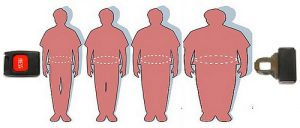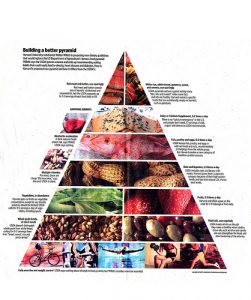Conquering Obesity

By: Mike Licht
Obesity continues to be a growing problem within the United States. According to the CDC 38% of U.S. adults are considered obese and 32.5% are considered overweight. An individual is considered obese if their Body Mass Index (BMI) measurements is greater than 30. BMI is the measure of body fat based on an individuals height and weight.
Does BMI Tell Us the Whole Story?
While the BMI scale is the most popular and convenient method to determine the risk of obesity, it does have its flaws. The BMI scale does not distinguish between fat mass and muscle mass. Other contributing factors such as ethnicity, age, sex and bone mass are not taken into account (Friedman, 2009.) Although the BMI scale has its flaws studies have shown a correlations between high BMI levels and health risks. Watch the video below to find alternative methods of determining body fat levels.
Why should you care about your body fat?
Being obese drastically increases the risk of several preventable diseases such as:
- Cardiovascular disease
- Diabetes
- Stroke
- High blood pressure
- Some forms of cancer
According to a study conducted by Borell and Samuels (2014), adults who are considered obese based on their BMI, are 20% more likely of dying from obesity related health risks compared to average weight adult.
One of the primary medical issues causing the health problems associated with Obesity is Metabolic Syndrome or Insulin resistance syndrome. With insulin resistance is the body’s cells are not responding to the insulin. Insulin is responsible for regulating glucose in the body. As a result, the body responds by producing even more insulin in order for the cells to absorb the glucose (Chaniotis and Papagiannakopoulou, 2016). Ultimately, the body now has increased insulin and glucose in the bloodstream. Increased insulin leads to high blood pressure, cardiovascular disease, heart attacks and diabetes (Chaniotis and Papagiannakopoulou, 2016).
What can we do to reduce the risk of Obesity

By: Phil Manker
The most effective way to reduce the risk of obesity is to create a negative energy balance. In simple terms this means we must expend more energy or calories than we consume. The most optimal way to achieve this goal is by eating a balanced diet consisting primarily of fruits, vegetables and lean proteins such as chicken or turkey. A balanced diet combined with physical activity for at least 45-60 min per day will produce the best results. Consistency is key, so remember make lifestyle changes that will allow you to be consistent.
For an individualized diet plan for your needs speak to your doctor or a dietician.
Debunking one of the Biggest Myths
You see it all the time in the gym, people performing exercises for their stomach and hips in hopes of losing body fat in that area. Unfortunately, fat can not be lost from a specific area. Fat loss occurs all over the body and we have no control over where that fat loss will come from.
The video above is perpetuating a myth that body fat can be lost based on where it is located and what exercise is performed. In reality everyone is genetically different. Where each person stores body fat will vary. But fat is lost as a whole not based on what exercises are performed. According to Perry (2011), “Ultimately, fat loss comes down not to targeted exercises, but to the basic principle of how many calories you expend versus how many you take in”. Next time you decide to exercise, focus on the total calories burned instead of the specific area being worked, when it comes to fat loss.
Recommendation
Media sources concerning obesity have shown to be reliable while providing valuable information about health risks. When it comes to exercising and losing body fat, the media can at time provide information that is incorrect or not the most optimal method. It is recommended to read from multiple sources on the best forms of cardiovascular activities to perform. In the end any form of physical activity that is performed consistently will be beneficial. Performing activities that are meaningful will maintain motivation while making it fun. Now go out there and make some posititive changes to your lifestyle!
References
Borrell, L. N., & Samuel, L. (2014). Body Mass Index Categories and Mortality Risk in US Adults: The Effect of Overweight and Obesity on Advancing Death. American Journal Of Public Health, 104(3), 512-519. doi:10.2105/AJPH.2013.301597
Chaniotis, D. d., & Papagiannakopoulou, L. (2016). Nutrition Education and Cardiometabolic Risk. E-Journal Of Science & Technology, 11(5), 1-12.
Friedman, J. M. (2009). Obesity: Causes and control of excess body fat. Nature, 459(7245), 340- 342. doi:10.1038/459340a
Perry, E. (2011, April 03). Targeted Fat Loss: Myth or Reality? Retrieved February 21, 2018, from http://www.yalescientific.org/2011/04/targeted-fat-loss-myth-or-reality/
